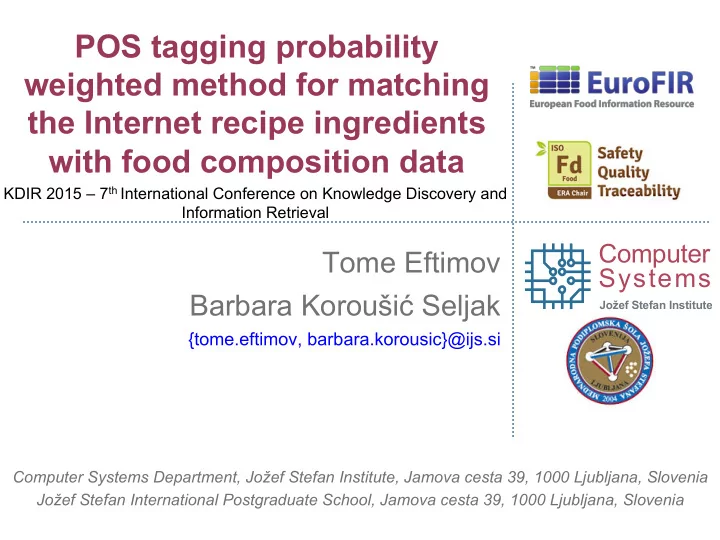

POS tagging probability weighted method for matching the Internet recipe ingredients with food composition data KDIR 2015 – 7 th International Conference on Knowledge Discovery and Information Retrieval Computer Tome Eftimov Systems Barbara Korou š i ć Seljak Jo ž ef Stefan Institute {tome.eftimov, barbara.korousic}@ijs.si Computer Systems Department, Jo ž ef Stefan Institute, Jamova cesta 39, 1000 Ljubljana, Slovenia Jo ž ef Stefan International Postgraduate School, Jamova cesta 39, 1000 Ljubljana, Slovenia
Overview • Motivation • Introduction • Related work • Problem definition • Evaluation and results • Conclusion
Motivation
Introduction • Food composition databases (FCDBs) • Internet recipes • Information retrieval method
Related work • Matching text concepts to an entry in a knowledge base has been addressed in many ways • Muller et al. (2012) presented a system that automatically calculates the nutritional content of recipes sourced on Internet • 6 human assessors manually evaluate list of ingredients for ambiguous ingredient names • 1,515 positively classified instances to witch they added the same number of negatively classified instances • features extraction and penalized regression model • 91.1% of the recipes they used were matched completely
Problem definition • People use human language to write the names of the used ingredients § “salt - iodised”, “iodised salt”, “salt, idodised” • Ingredient synonymy problem • The form of the ingredient and the cooking process
Proposed method (1/2) • POS tagging (NN*,JJ*,VB*) • String similarity - Jaccard index • Laplace probability estimate
Proposed method (2/2)
Evaluation and results • Data – collection of 721 recipes written in English 1 • 1,615 different names of ingredients • EuroFIR FCDB 2 § food table § ENGFDNM • 44,033 English names of food analyses 1 http://allrecipes.com/ 2 EuroFIR – non-profit Association under the Belgian law, http://www.eurofir.org/
Data pre-processing • Remove punctuations • Convert each name in lower case letters • Whitespace tokenization • Lemmatization, only for nouns • Manually created rules (without skin; skinless), (with salt; salted)
Experiment 1 Recipe FCDB Code gibanica prekmurska gibanica RECMEM000162 sojina omaka tamari omaka sojina (iz soje) 16124 pomaranče pomaranča P0402 melona casaba 9183 melona melona honeydew 9184
Recommend
More recommend